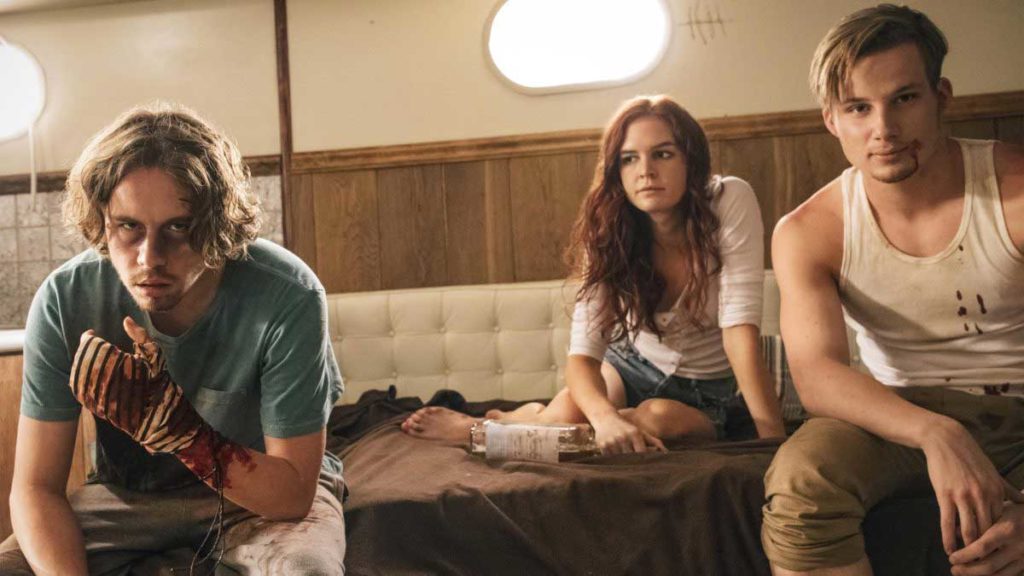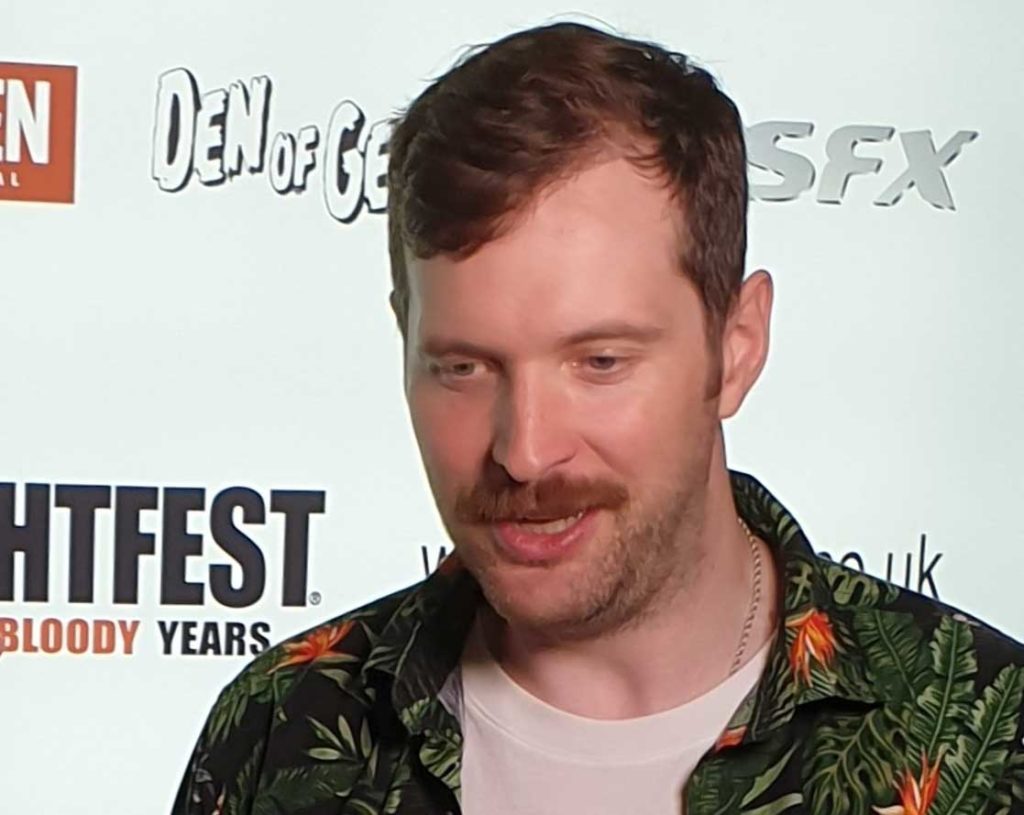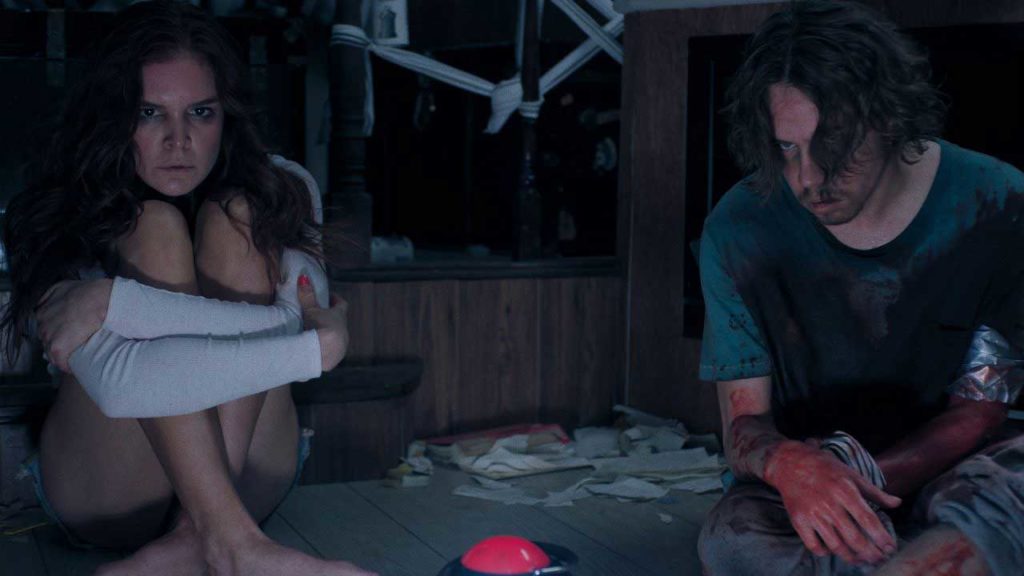
After making quite a splash at this year’s Arrow Video FrightFest, Rob Grant’s Harpoon arrives on The Arrow Video Channel from Friday 18th October…
Jean-Paul Sartre famously wrote, Hell is other people. In Harpoon, they are also your closest friends.
A gleefully caustic, witty and violent film about three pals self-destructing when they’re accidentally stuck in a boat out on the ocean, it is rollercoaster horror in the best sense. Snide remarks soon turn darker as resentments and long-held secrets begin to surface, while an omniscient narrator (Fleabag’s Brett Gelman) keeps tabs on their predicament.
Regular readers of this site will be aware of Arrow Video and what they do, i.e., sensational Blu-rays that line many a shelf – I’m looking at my Carrie box set right now… The Arrow Video Channel is that but ready to go on your TV. A mixture of cult classics and brand new movies, it will also feature an expanding collection of documentaries, interviews and other goodies from the Arrow archives.
The Arrow Video Channel is available on Apple TV, Amazon Prime and select Samsung smart TVs
Back to Harpoon, Daniel Perry, Arrow’s Head of Digital, said, “We are honoured and excited to be launching Harpoon on the Arrow Video Channel exclusively as our first premiere title this October. Harpoon is a perfect example of the quality of film we will be bringing every month to the channel.”
Writer/director Rob Grant also gets straight to the point about the film in the below interview we conducted with him at this year’s FrightFest.
He talks about how Harpoon came to be and the challenges he had in funding and shooting. Plus, how he attracted the fantastic cast of Emily Tyra, Christopher Gray and Munro Chambers as the three frenemies, literally all at sea.
The result is a compelling insight into the practicalities, difficulties and opportunities of indie filmmaking.
Rob Daniel: How did the idea for Harpoon come about?

Rob Grant: I have a really strange writing process. In the Notes app on my phone I’m usually writing down little bits of ideas. I had the premise of three people stuck on a boat, but didn’t know what the themes or ideas were going to be. It usually takes me about three years before an idea gestates enough that I can actually vomit out a really bad first draft.
I had the setting, but didn’t know what I wanted to talk about until I realised it would focus on friendship and betrayal. Especially long term friendship.
RD: Phew, for a minute I thought you were going to say it was autobiographical…
RG: Ha! Well, there’s an element I hope people can relate to with an old friend, or maybe an old shithead they know! A lot of elements were taken from people I know and my own thoughts. Obviously nothing as extreme as in Harpoon, but you want it to land close enough to real experiences that it doesn’t feel outlandish.
RD: Was it easy to cast? The roles seem to require very specific types and put a lot of demands on the actors.
RG: I was worried because as an actor I could imagine them reading the script and thinking, this is a big risk and I could look like an idiot if it doesn’t go well. But, we got very lucky that we had 360 Management, an agency from LA we’d worked with prior. We gave them the script and asked if they had anyone from their pool they’d want to put forward.
They gave us Christopher Gray who plays Richard and Emily Tyra who plays Sasha, and after talking with them, they seemed like the right fit. Munro Chambers I’d known from Turbo Kid and editing Knuckleball, my producer’s movie. Casting Munro didn’t compute to me at first, but over conversations and doing a tape with him I realised he was the right person. Especially as his role as Jonah, and what happens in the film, was kind of the hardest one to make sure it worked.
RD: You say you wrote it over a period of time…
RG: Sorry, the ideas formed over time, but the writing only actually took three or four months. When I pitched my producer Mike (Petersen) the idea I told him I thought it was coming together as Polanski’s Knife in the Water meets Seinfeld, and he told me to put that down on paper.
So I hammered out a vomit draft, probably over a long weekend, and then it was back and forth with redrafts. But, I pitched it in around October and it was shooting in January, so a very quick turnaround.
RD: Did the cast bring anything to the script, or was it important that they stick to the dialogue as written?
RG: The first draft they read felt different, the narration was different. But the themes and ideas were all there. We did change the script when we had three days of rehearsals just to finesse and make sure the dialogue sounded correct when spoken.
But, most of the script on the screen is what was written. For a fifteen day shoot you don’t really get a ton of time to improvise. Although it’s a tribute to the cast that they brought the script to a different level than what I had on the page.
RD: But none of them went full method?
RG: No, luckily not! But, these were such exhausting roles that by the end of the day they didn’t have much energy for extra talking and stuff. They’d be going home just to get back into these really aggressive mind spaces the next day.
RD: Was the narration always part of the script or was it brought in to lighten the mood?
RG: Different forms of it were always there. At one time it was way more on the nose about the themes, which ultimately it didn’t need to be. But, it was always there for the sole reason that I didn’t want three close friends having to spout expositional backstory to each other.
So I thought, let’s have this narrator say all that stuff so that when the characters are interacting, they don’t have to say, “Remember there was that time we did this thing.”
RD: I thought the narrator worked well to punctuate the ridiculous escalations of the character feuds and provide commentary on them.
RG: Luckily, that came secondary. Originally the narrator was there to set up backstory, but then we found he was also a good entry way for the tonal shifts between comedy and seriousness. He was a good way to break the tension… and set up more tension. Just through the editing process this is stuff that you learn.
RD: The film is visually compelling. Was this a challenge as you were shooting largely in a single location?
RG: The biggest decision we made that was best for the movie was one camera only. On indies, especially on a fifteen day shoot, you tend to go with two cameras so you can get your coverage quicker. But, I realised on previous films that you can’t concentrate on composition and everything else when you have two cameras running, there’s just too much going on.
With single camera I could concentrate on performance and I told my DoP to look for what was interesting. We made sure each shot punctuated or accented the action and was from the best possible angle. So, that was kind of what we did to make sure that visually nothing was repetitive.
Interestingly, we found out in a talky movie, actors can get nervous they’re not being exciting enough. So they start doing “busy work”, you know, the Steve McQueen shaking shotgun shells, moving around and fidgeting. I noticed in rehearsals they were moving around a ton, so I had to remind them their characters were days without food, so they should sit and act like a normal human being in that situation.
We made a conscious effort that they would not move for most of the shots and the camera kind of does the same thing, to allow you to focus on their discussions.
This was all for the interiors. With the exteriors, when we knew we’d be having to dealing with elements on a real boat on the ocean, we made sure that we were prepared. No light, just a bounce board and the camera guy. That’s why the exteriors feel a little more handheld, because we knew we didn’t have the time or equipment to do elaborate set-ups out on the ocean.
RD: Those external scenes had a nice bleached-out look though, conveying the fact that there was nowhere to hide.
RG: Yeah, exactly.

RD: So, was this an easy film to get funding for?
RG: Errrrr, no. The first person we showed the script to had a really negative reaction. They said it was an unsellable movie. I get it, it’s a tough pitch, but I approached it as, if this was the last movie I got to do I wanted to go for broke and try things I was scared of or didn’t know if they worked with an audience because… why the hell not? It might be my last opportunity.
Luckily, Mike Peterson believed in the concept that it could be all these different genres in one movie. He managed to raise funding with people we’d worked with prior. They took a chance on us and I’m really glad they gave us the opportunity to mess around with such a weird experiment.
RD: So you weren’t asked to lighten the script or make it more comedic?
RG: No, as soon as we got the right people on board to fund it, they were hands off and let us do what we wanted to do.
But, in the editing room you always have discussions with the producer over where we’re hitting the mark and where we’re not. But, this one in particular we had no clue until it was in a theatre full of people if any of it was going to work. A lot of chances were taken on this project, but they seem to be paying off!
RD: Fair to say the film gets quite violent. Was there anything in the script that you had to pull back on when filming?
RG: No, never. My philosophy on movie violence is I don’t like watered down stuff because it makes it look easy. If I show violence, I feel I have an obligation to show how awful it is, and you should be grossed out by it.
I wanted to use that in the script where throughout characters casually talk about how easy it would be to pull off, but when it arrives they realise it is very bad and very awful. And, as the movie talks about certain acts of violence for 70 minutes, it had better hit 11 on the scale when it arrives is how I looked at it.
RD: Is that also the reason you went with practical effects rather than CGI, so the actors would really have to get in there?
RG: Yep, but also because we didn’t have the visual effects budget either! Practical is the right way to go as long as it’s pulled off correctly. We made sure that… specific prosthetics worked well (laughs).
RD: You mentioned you didn’t know what you’d got until you put Harpoon in front of an audience. What has the reaction been on the festival circuit?
RG: Festival audiences are quite forgiving. When we first started pushing the movie, we made the mistake of submitting a rough cut. Big mistake, I’ll never do that again. The sound wasn’t all there, the colours weren’t all there, it was a big ask for people to imagine how it would look when it was all done.
So, we were getting no’s left, right and centre until Rotterdam took a chance on us for the premiere. They’re not even a genre festival, they’re a big European arthouse festival. But, it was there we realised we might have made something interesting. Off the back of the reaction there, we got people to take a second look and the momentum has grown, so hopefully that will continue.
RD: How does it feel to play FrightFest?
RG: I’ve never been to FrightFest, I’m super excited by the audience. I’ve said it before, I think the tone of this movie plays to a good, dry British sensibility, so I’m interested to see if that assumption is correct.
RD: What’s next for you?
RG: I’m going to take a bit of a break, for sure. It’s a hard business, especially with the indie model now, you’ve just got to crack through. So, I’ve got to make sure that what I do next is a step in a different direction or challenging to me. But first, time to recharge the batteries.
Rob Daniel
Twitter: rob_a_Daniel
iTunes Podcast: The Electric Shadows Podcast
Thanks to Rob Grant for making this interview possible.
Harpoon will be released on Arrow Video at a future date.
